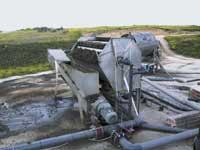Environmental impact of agricultural fertilizers
2002/12/01 Andonegi Beristain, Garazi - Elhuyar Zientziaren Komunikazioa Iturria: Elhuyar aldizkaria
The problem is in intensive agriculture. Currently, some farmers have an excess of beef compared to the rural area. Therefore, they apply the manure (dirtiest manure of stables) to high concentrations in land, especially in areas near the stables. On the other hand, they buy mineral fertilizer for distant lands. The application of mineral fertilizers and manure in large quantities can cause serious environmental problems.
The UPV Department of Plant Biology and Ecology has been working in this field for 12 years. The aim of the researchers is to measure the efficiency of conventional agricultural fertilizers and analyze their impact on the environment.
Importance of nitrogen
Most fertilizers used in agriculture have as main component nitrogen. Nitrogen accelerates plant growth and production. However, the excessive application of nitrogen in the land causes the plants not to use the entire nitrogen and problems occur. On the one hand, gases are emitted and on the other, water is polluted.

Gas emissions due to soil microorganisms occur when several nitrogen compounds are taken off. Some of these compounds, such as nitrous oxide (N2O) and nitric oxide (NO2), can cause serious environmental problems. The first of these significantly affects the greenhouse effect and is one of the most dangerous compounds along with carbon dioxide (CO2). And nitric oxide can produce rain acid.
In addition to gaseous emissions, water pollution must be taken into account. When nitrogen is in the form of nitrate (NO3), along with rainwater you can reach drinking water wells, rivers and lakes. Health problems may occur in drinking water. In the second case, it helps water eutrophication. When there is eutrophication, the microorganisms and aquatic plants grow too much, the oxygen is wasted from the water and the fish are drowned.
History of research
Faced with these problems, the researchers made a comparison between mineral fertilizers and purines. The conclusions point out that purine acts as fertilizer more slowly, but that both fertilizers are equivalent in gaseous emissions and in water pollution capacity. Therefore, one cannot say that one is better than the other.
The second step was to look at the characteristics of the lands: a comparison was made between the fields of grass and the fields of cultivation. The study reveals that gas emissions in the fields are higher, while in rural areas there is a greater risk of nitrate reaching water.
Finally, researchers study the growth inhibitors of soil microorganisms that produce nitrate, nitrous oxide and nitric oxide. For what? This reduces the emission of gases and the accumulation of nitrates in the water. It is now being observed whether inhibitors also reduce plant growth, inhibitor capacity is being measured, ground production has been modified and gas emission measurements are being made. All of them, along with many other studies, continue to work on this topic.
- Project title Efficient use of nitrogen fertilizers.
- Objective To reduce the environmental risk of gas emissions and nitrogen nitrate leaching.
- Project Director Carmen González Murua.
- UPV Template: C. Gonzalez Murua, J.M. Estavillo, B. González Moro, X. Macadam, S. Menéndez, L. Careaga, T. Outdoors.NEIKER: M. Pinto, P.Merino, A. Del Prado, G. Besga, R. Saiz.
- Department of Plant Biology and Ecology.
- •
- Financing: UPV/EHU, Department of Agriculture of the Basque Government, Ministry of Science and Technology, European projects, Compo-Agri S.A.

Gai honi buruzko eduki gehiago
Elhuyarrek garatutako teknologia





